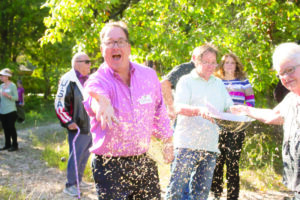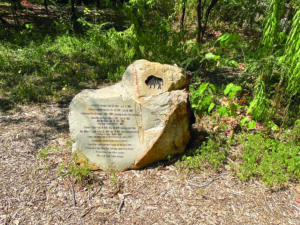HIDDEN GEMS OF WHITE ROCK
By Natalie Merrill
Nestled in the Forest Hills area of East Dallas, the Warren Ferris Cemetery serves as a historic landmark that honors early settlers and individuals in the indigenous community. The cemetery was established in the mid-1800s on the Ferris family’s 640-acre property and was used not only by the family but also by the surrounding community.

Photo courtesy of the Friends of the Warren Ferris Cemetery
Though the current cemetery spans a much smaller plot of land, the amount of history and significance contained within it has not wavered. In order to ensure this, the Friends of the Warren Ferris Cemetery (FWFC) makes concerted efforts to preserve the land and honor the individuals who are buried there.
Patty Griffin, who has a background in education, first became involved with the Warren Ferris Cemetery property as a member of the North Dallas Master Naturalists because of her interest in volunteering in nature-oriented capacities. She participated in the cleanup and restoration of the property and aimed to help it become an inviting place for wildlife and an appealing place for people to visit as well. Her continued participation in the workdays at the cemetery sparked her interest to become more involved with the FWFC.
“The history behind the cemetery and of Warren Ferris is fascinating,” she said. “The FWFC helps to ensure that those buried there are honored and recognized. A new headstone was placed for Benjamin Dye, a veteran of the War of 1812, whose exact grave location is unknown. Much research was put into learning who was buried on the property, which was originally four acres and stretched all the way down to the creek. This year, the board installed a beautifully engraved stone (pictured) that lists all those now known to be buried there.”
Throughout time, Griffin became acquainted with Julie Fineman, the vice president of the board of the FWFC. When Fineman learned Griffin was a teacher, she asked her to join the board as the education director in an effort to develop a relationship with the Alex Sanger Preparatory School across the street from the cemetery.
“We wanted to form a partnership to help them find ways to incorporate the gifts of nature into any subject matter and at every grade level,” Griffin said. “We are encouraged by their positive interest in experiential learning and in using the cemetery for their educational purposes, and we are here to help that happen.”
Alex Merritt, principal of Alex Sanger Prep, said he discovered the cemetery while on a walk with colleagues a few years ago to get outside during the first year of the pandemic. At the time, he was an assistant principal at the school. Griffin reached out last summer, and when Merritt returned from vacation and was named principal, he knew the partnership with the FWFC would be highly beneficial for teachers and students because of the learning opportunities it will provide.
“We know a lot about how children learn, and they don’t learn anything new in the abstract,” he said. “Experiential learning grounds kids in the things they can touch and feel and experience so that when they encounter it elsewhere, they have this experience to fall back on. That’s a rich experience they can pull from.”
Merritt said many students might not have previously known about the cemetery, even if they have seen it in the neighborhood, and becoming more familiar with it allows them to learn more about not only a historical marker within their community, but also more about themselves.

“When it comes to history, you absolutely want them to know the history of their own community — where they fit into it and who paved the way for them,” he said. “A graveyard can spark that interest. This is their neighborhood, and I bet a lot of the kids know it’s there, but they may not know the story of it and how it connects with them.”
And for Merritt, ensuring that students are able to form those connections that help them discover more about themselves is essential.
“Social studies in the lower grades of elementary school starts in your neighborhood,” he said. “Grounding them here where they are right now helps them start with their identities, and it grows and grows from there.”
While the cemetery provides educational opportunities for students, it also creates a unique space for residents and visitors to spend time and appreciate the nature and peace it offers.
“The Warren Ferris Cemetery is a beautiful wildlife habitat and Monarch Waystation open for all to enjoy,” Griffin said. “We encourage the local community to come and enjoy the seasonal changes and peacefulness the property provides. We provide places for people to sit in the shade and read, sketch, journal or explore the variety of wildlife to be found.”
Griffin also noted that the work of the board is not complete. Individuals who wish to contribute to the Friends of the Warren Ferris Cemetery can make donations at friendsofthewarrenferriscemetery.org and discover more on how the organization hopes to continue to preserve and honor the historical landmark.
“The FWFC has a lot more land restoration to do,” she said, “and as we remove invasive plants and shrubs, we plant new sedges, grasses, native shrubs, flowers and trees, which all take funds to purchase.”
